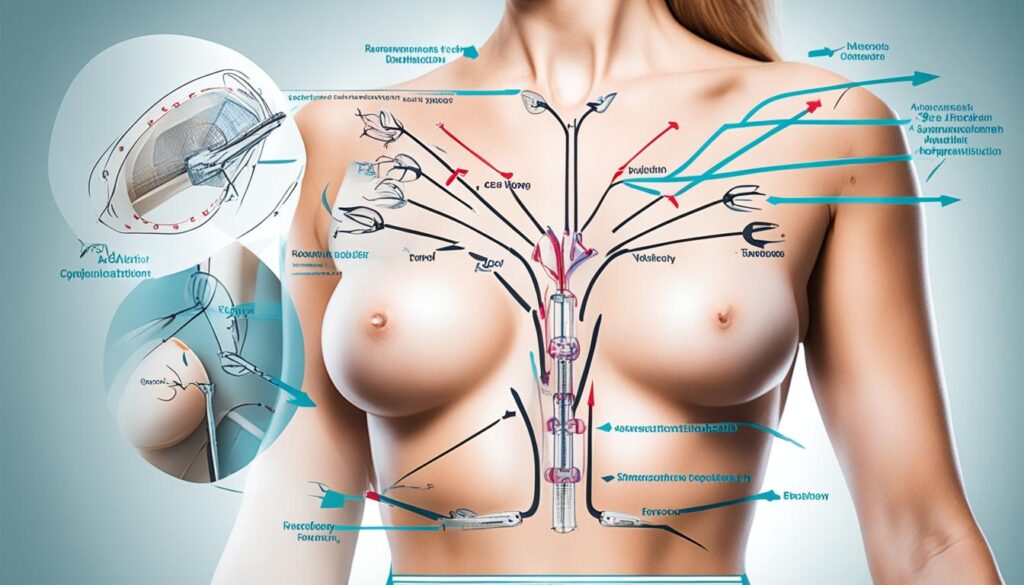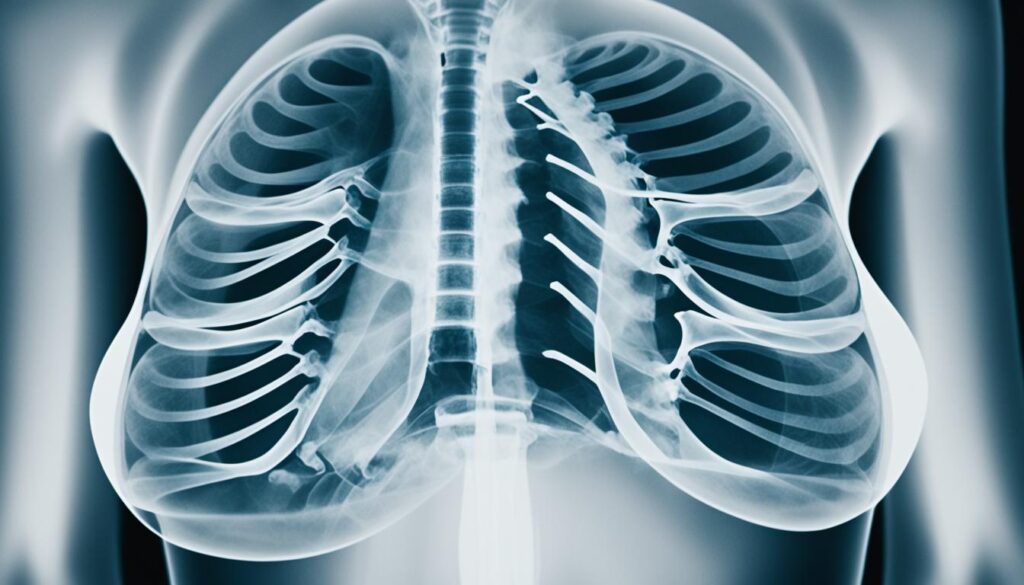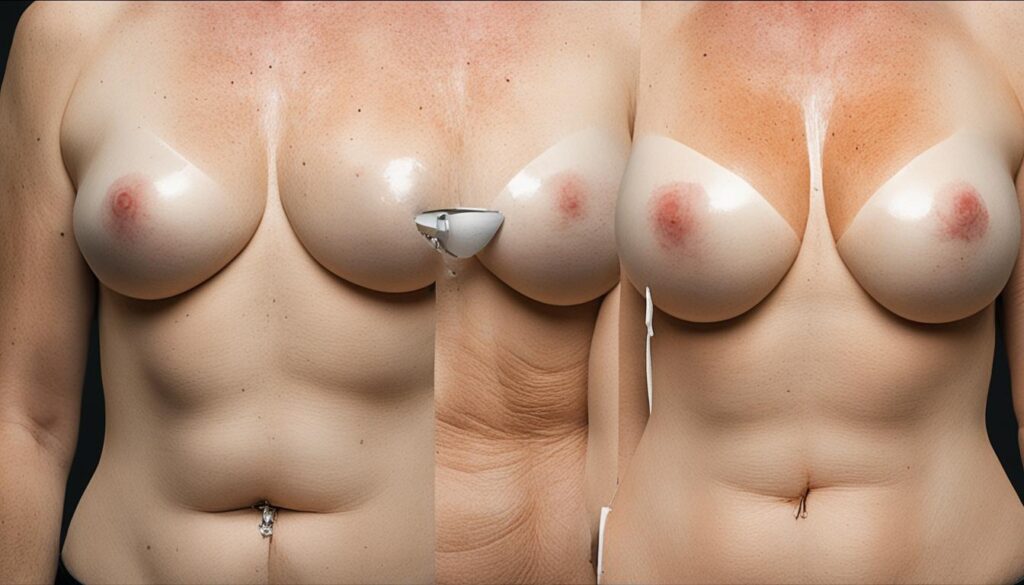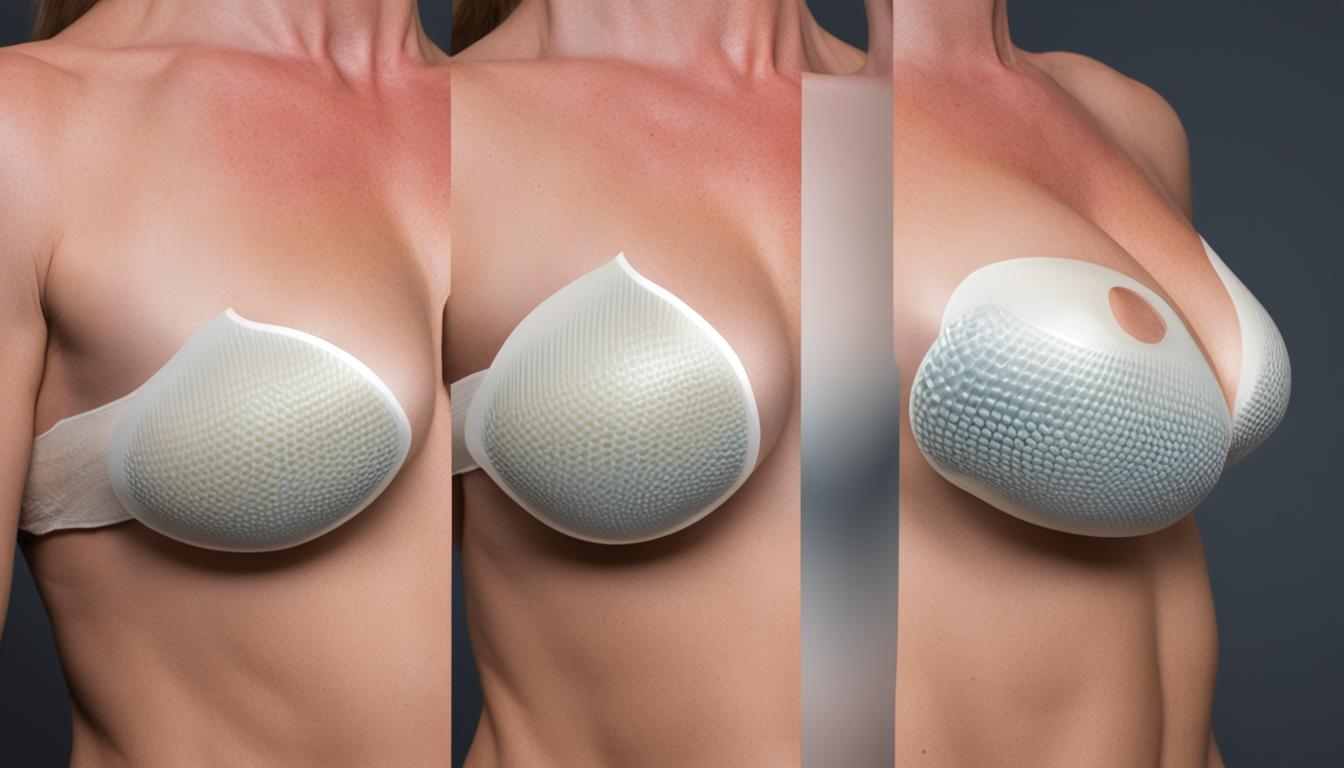Looking at my reflection, doubt crept in. The choice to have breast enlargement surgery bore weight. All at once, I felt eager yet wary. The desire for confidence fleeted with thoughts of upcoming challenges.
The FDA warns of possible downsides to breast implants. Learn about breast pain and changes in feeling in your breasts and nipples here. There’s also a risk of needing more surgeries or developing uncommon types of cancer.
As I researched more, I learned that breast implants aren’t forever. The longer I have them, the likelier I am to face issues. Knowing I might need them removed or have other surgeries later fills me with dread.
I ponder the impact on my life. Will these risks affect my day-to-day, relationships, and happiness? It’s tough making this serious choice while considering my future well-being and values.
Key Takeaways
- Breast implant complications can occur in at least 1% of patients at any time.
- Patients may require additional surgeries the longer they have breast implants.
- Complications can include asymmetry, breast pain, capsular contracture, rupture, and rare forms of cancer.
- Implant removal may involve leaving the scar tissue in the body or a more extensive surgical removal.
- Patients with confirmed BIA-ALCL may require a different type of surgery for implant removal.
Introduction
Breast augmentation is a surgery that improves a woman’s look and self-esteem. It is commonly known as augmentation mammaplasty. During this surgery, doctors place implants under the breast tissue or chest muscles. This makes the breasts bigger and rounder.
Overview of Breast Augmentation Surgery
Plastic surgeons often perform breast augmentation. They use implants filled with saline or silicone gel. This surgery helps create a more balanced and beautiful bust line. It does this by improving the size and shape of breasts that are small or uneven.
Why Women Opt for Breast Enlargement
Many women choose this surgery to look and feel better. They might feel their breasts are too small or lopsided. Some women want to regain breast fullness lost after pregnancy or losing weight. Others aim to fix issues from prior breast surgeries.
In talking with their surgeon, women set their goals and manage expectations. This helps ensure they are happy with the results. It also boosts their confidence and self-esteem.
Potential Complications and Adverse Outcomes
Up to 1% of breast implant patients can face certain issues. These may include changes in breast sensation, visible wrinkling, and rippling. More serious problems like implant rupture, capsular contracture, or infection might also happen.
Implant Complications
Common problems with breast implants are not hard to find. They can lead to asymmetry, breast pain, or even deformities. Patients might need other surgeries to fix these issues breast implant side effects.
Additional Surgeries
Breast implants won’t last forever. The longer you have them, the more problems might arise. This could lead to more surgeries, either to fix or remove the implants.
Implant Removal
Getting your breast implants removed is a big procedure. It might involve keeping the capsule or taking it out. Anyone considering breast implant removal should know it comes with a recovery process.

Breast Implant-Associated Anaplastic Large Cell Lymphoma (BIA-ALCL)
An uncommon cancer, anaplastic large cell lymphoma (ALCL), has a possible link to breast implants. This link is called breast implant-associated anaplastic large cell lymphoma (BIA-ALCL). The FDA suggests that if your breast implants are textured, there’s a very small chance of getting BIA-ALCL. But, we need more research to know for sure.
The FDA states the current risk of BIA-ALCL is 1 in 2,207 to 1 in 86,029 women with textured breast implants. Signs of BIA-ALCL might show up more than a year after the implant. This often happens 8 to 10 years after getting the implant.
If you see signs like constant swelling, pain, or changes near your breast implant, tell your doctor. They might use ultrasound or MRI to check for any issues. A special test called CD30 immune staining (CD30IHC) helps confirm BIA-ALCL.
Early-detected BIA-ALCL can be treated successfully in many cases. The ASPS supports using the NCCN guidelines for treatment. Options may include removing the implant, testing the lymph nodes, and sometimes chemo or radiation. Monitoring can last for two years after treatment.
To help others, the FDA asks doctors to report all BIA-ALCL cases to the PROFILE registry. This registry is supported by the ASPS/PSF to understand more about BIA-ALCL.
What are the risks associated with breast enlargement surgery?
Before getting breast enlargement surgery, it’s important to know the risks involved. One issue is capsular contracture. It happens when scar tissue tightens around the implant, making the breast feel hard.
Capsular Contracture
Capsular contracture can make the breast seem firm, painful, or look odd. It might need a second surgery to fix the issue by removing the scar tissue.
Implant Rupture and Deflation
Implant rupture and deflation occur when the implant leaks or tears. This causes the breast to change in shape. Fixing this problem might require another surgery.
Infection and Inflammation
Infection and inflammation can happen around the implant after surgery. Signs include redness, swelling, and pain. This needs treatment or more surgery to heal.
Prior to surgery, it’s critical to talk to the surgeon about these risks. This allows patients to decide if breast enlargement is a good choice for them.

Breast Implant Illness and Systemic Symptoms
Sometimes, patients with breast implants feel sick all over, not just near the breasts. This condition is known as “breast implant illness.” Symptoms can be like feeling tired, forgetting things, joint pain, and skin problems.
Fatigue and Brain Fog
Some people with breast implants might always feel tired and have trouble thinking. They may forget things or find it hard to focus. It’s not clear if the implants cause these symptoms. But, taking out the implants has helped some people feel better.
Joint Pain and Skin Rashes
Breast implant illness can cause joint pain that doesn’t make sense and skin rashes. These symptoms can make life hard. Doctors are still looking into how breast implants might lead to these issues. But, some people have felt better after having their implants removed.
If you see these signs, speaking with your surgeon or doctor is crucial. They can check your condition thoroughly. Then, they will guide you on what steps to take next, which might involve implant removal.

Surgical Risks and Complications
Breast augmentation surgery has its own share of potential problems. This includes risks from surgery itself like bleeding and the collection of blood near the surgery area. It also involves risks from the use of anesthesia and issues with scarring and healing. Knowing about these risks is important for anyone thinking about this surgery.
Bleeding and Hematoma
Bleeding and hematomas are things to watch out for after breast augmentation surgery. If bleeding is too much or if a hematoma forms, it can need a doctor’s care. This might involve draining the area with surgery. It’s vital for patients to know the signs of these, like swelling, bruises, or extra pain. They should tell their plastic surgeon right away if they notice any of these signs.
Anesthesia Risks
The operation’s anesthesia can also be risky. Patients should talk to their surgeon and anesthesiologist about any health worries they have. It’s good to stop smoking before and after surgery. This can help with healing and lower the dangers linked with anesthesia.
Scarring and Wound Healing Issues
After breast augmentation, there will be some scarring. Yet, some people might have a hard time with their incisions healing right. This can lead to visible scars or wounds that heal slowly or get infected. Patients must carefully follow what their surgeon tells them to do after the surgery. This can help reduce these risks and make sure they heal well.

Breast Augmentation and Mammograms
Women with breast implants need special imaging for their mammograms. With implants, it’s harder for doctors to check the breast tissue closely with the usual mammograms.
Specialized Imaging Techniques
Women may require extra tests like MRI or ultrasound besides mammograms. These tests help doctors see the breast tissue around the implants clearly. They help to find issues like breast implant rupture or silicone leakage.
FDA Recommendations for Routine Screening
The FDA advises women with silicone gel-filled breast implants to get an MRI or ultrasound for ruptures every five to six years after the surgery. Then, they should check every two to three years. This check-up is key even if you feel fine. It’s to spot any breast implant problems early.
| Screening Recommendation | Frequency |
|---|---|
| MRI or Ultrasound for Implant Rupture | Every 5-6 years after implantation, then every 2-3 years |
Obeying the FDA’s advice is crucial for your breast health. Using special breast implant imaging works alongside regular checks. This way, your breast health is closely watched.

Long-Term Considerations
Starting the journey towards breast enlargement means knowing the journey’s long-term realities. It’s important to be aware of the life span of breast implants and possible future surgeries.
Implant Lifespan and Replacement
Remember, breast implants aren’t forever. They might need replacement, often within around 10 years. This means you might need more than one surgery to keep up with your breast appearance and handle any issues.
Breast Changes Due to Aging and Weight Fluctuations
Your breasts may look different over time due to various reasons like aging, pregnancy, and weight changes. Such changes might need surgeries to cope with.
Be ready for more surgeries if your implants need a change. This helps keep your breasts looking the way you want and deal with any problems.

Conclusion
Breast enlargement surgery comes with many risks. These include problems with the implants, like capsular contracture or rupture. Patients might also face “breast implant illness.” This is when people experience several symptoms believed to be linked to their implants.
There are also risks during the surgery, such as bleeding and infection. It’s essential to know that breast implants don’t last a lifetime. They usually need to be replaced every 15-20 years due to various changes like aging or weight fluctuations.
Deciding on breast enlargement is deeply personal. Anyone considering it should talk openly with their plastic surgeon. This helps in fully grasping the breast augmentation risks and breast implant complications. This way, they can make a decision they’re well-informed about.
